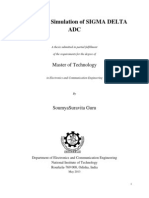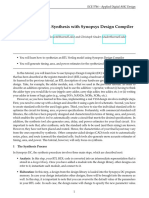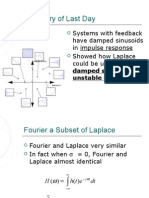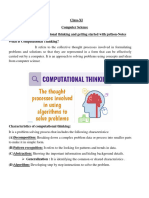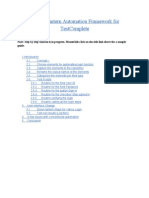Scripting Language - TCL/TK: 5.1 How Not To Use Scripting Languages
Uploaded by
Rugina MariusScripting Language - TCL/TK: 5.1 How Not To Use Scripting Languages
Uploaded by
Rugina MariusChapter
Scripting language - Tcl/Tk
cripting is difficult to define. It has existed for a long time - the first scripting languages were
job control languages such as the shell program found in Unix systems. Modern scripting
languages such as Perl, Tcl, Python, awk, Ruby and so on are general purpose, but often they
have more powerful basic operations than those found in conventional general purpose computer
languages. For example it is common to have operators that perform regular-expression pattern
matching in a scripting language.
Scripting languages are normally interpreted, and the interpreter contains the routines to do the
pattern matching. One line of script code may be equivalent to 100 lines of C. However, the
overhead in having a (say) 3MB script interpreter is sometimes a problem, although less so these
days.
Perl is widely used, as it is found in active web page developments. Tcl/Tk is useful for GUI
development, allowing us to prototype new GUI applications quickly.
5.1 How not to use scripting languages
Dont use to the exclusion of other languages!
Scripting languages are very good at some things, but sometimes frustratingly bad at other things.
For example, many scripting languages use associative, text-based array indexes, and so a simple
array lookup may take 1000 times longer than an equivalent lookup in a compiled language.
For this reason, it is common to mix scripting and other languages.
45
46
Scripting language - Tcl/Tk
5.2 Tcl/Tk
Wish - the windowing shell, is a simple scripting interface to the Tcl/Tk language. The language
Tcl (Tool Command Language) is an interpreted scripting language, with useful inter-application
communication methods, and is pronounced tickle. Tk originally was an X-window toolkit
implemented as extensions to tcl. However, now it is available native on all platforms.
The program xspin is an example of a portable program in which the entire user interface is
written in wish. The program also runs on PCs using NT or Win95, and as well on Macintoshes.
A first use of wish could be the following:
manu> wish
wish> button .quit -text "Hello World!" -command {exit}
.quit
wish> pack .quit
wish>
You can encapsulate this in a script:
CODE LISTING
HelloWorld.tcl
#!/usr/local/bin/wish8.1 f
button .quit text "Hello World!" command {exit}
pack .quit
5.2 Tcl/Tk
47
If you create this as a file, and make it executable, you should be able to run this simple graphical
program.
5.2.1 The structure of Tcl/Tk
The Tcl language has a tiny syntax - there is only a single command structure, and a set of rules
to determine how to interpret the commands. Other languages have special syntaxes for control
structures (if, while, repeat...) - not so in Tcl. All such structures are implemented as commands.
There is a runtime library of compiled C routines, and the level of the GUI interface is quite
high.
Comments: If the first character of a command is #, it is a comment.
Tcl commands: Tcl commands are just words separated by spaces. Commands return strings,
and arguments are just further words.
command argument argument
command argument
Spaces are important:
expr 5*3
expr 5 * 3
has a single argument
has three arguments
Tcl commands are separated by a new line, or a semicolon, and arrays are indexed by text:
set a(a\ text\ index) 4
Tcl/Tk quoting rules :
The "quoting" rules come in to play when the " or { character are first in the word. ".." disables a
few of the special characters - for example space, tab, newline and semicolon, and {..} disables
everything except \{, \} and \nl. This facility is particularly useful for the control structures - they
end up looking very like C:
while {a==10} {
set b [tst a]
}
48
Scripting language - Tcl/Tk
Tcl/Tk substitution rules:
Variable substitution: The dollar sign performs the variable value substitution. Tcl variables
are strings.
set a 12b
set b 12$a
a will be "12b"
b will be "1212b"
Command substitution: The []s are replaced by the value returned by executing the Tcl command doit.
set a [doit param1 param2]
Backslash substitution:
set a a\ string\ with\ spaces\ \
and\ a\ new\ line
Tcl/Tk command examples:
Procedures
File Access
Miscellaneous
proc name {parameters} {body}
open <name>
source <NameOfFile>
read <fileID>
global <varname>
close <fileID>
catch <command>
cd <directoryname>
format <formatstring> <value>
exec <process>
return <value>
List operators:
split
<string> ?splitcharacters?
concat <list> <list>
lindex <list> <index>
... + lots more
Control structures:
if {test} {thenpart} {elsepart}1 while {test} {body}
for {init} {test} {incr} {body}
continue
case $x in a {a-part} b {b-part}
1
The Tcl/Tk words then and else are noise words, which may be used to increase readability.
5.2 Tcl/Tk
49
Widget creation commands:
The first parameter to each is a dotted name. The dot heirarchy indicates the relationships
between the widgets.
%
%
%
%
%
label <name>
canvas <name>
button <name>
frame <name>
... and so on
optional
optional
optional
optional
parameter
parameter
parameter
parameter
pairs
pairs
pairs
pairs
...
...
...
...
When you create a widget ".b", a new command ".b" is created, which you can use to further
communicate with it. The geometry managers in Tk assemble the widgets:
% pack <name> .... where ....
5.2.2 Tcl/Tk example software
Here is a very small Tcl/Tk application, which displays the date in a scrollable window:
The code for this is:
CODE LISTING
SimpleProg.tcl
#!/usr/local/bin/wish8.1 f
text .log width 60 height 5 bd 2 relief raised
pack .log
button .buttonquit text "Quit" command exit
pack .buttonquit
button .buttondate text "date" command getdate
pack .buttondate
proc getdate {} {
set result [exec date]
.log insert end $result
.log insert end \n
}
50
Scripting language - Tcl/Tk
Here is tkpaint - a drawing/painting program written in Tcl/Tk:
The mainline of the source just creates the buttons, and packs the frame:
CODE LISTING
tkpaint1.tcl
#! /usr/local/bin/wish f
set thistool rectangle
set thisop grow
set thiscolour black
button .exitbtn
bitmap @exit.xbm
command exit
button .squarebtn bitmap @square.xbm
command setsquaretool
button .circlebtn bitmap @circle.xbm
command setcircletool
button .shrnkbtn bitmap @shrink.xbm
command "set thisop shrnk"
button .growbtn
bitmap @grow.xbm
command "set thisop grow"
button .printbtn bitmap @print.xbm
command printit
button .colorbtn bitmap @newcolour.xbm command setanewcolour
canvas .net width 400 height 400 background white relief sunken
canvas .status width 40 height 40 background white relief sunken
pack
pack
pack
pack
pack
.net side bottom
.status side right
.squarebtn .circlebtn side left ipadx 1m ipady 1m expand 1
.exitbtn .printbtn side right ipadx 1m ipady 1m expand 1
.colorbtn .shrnkbtn .growbtn side right ipadx 1m ipady 1m expand 1
bind .net <ButtonPress1> {makenode %x %y}
.status create rectangle 10 10 37 37 tag statusthingy fill $thiscolour
set nodes 0; set oldx 0; set oldy 0;
Routines for dragging, scaling and printing:
CODE LISTING
tkpaint4.tcl
proc beginmove {x y} {
global oldx oldy
set oldx $x; set oldy $y
}
proc domove {item x y} {
global oldx oldy
.net move $item [expr "$x $oldx"] [expr "$y $oldy"]
set oldx $x; set oldy $y
}
proc altersize {item x y z} {
.net scale $item $x $y $z $z
}
proc printit {} {
.net postscript file "pic.ps"
}
5.2 Tcl/Tk
51
Node operations for tkpaint:
CODE LISTING
tkpaint2.tcl
proc makenode {x y} {
global nodes oldx oldy thistool thiscolor
set nodes [expr "$nodes+1"]
set x1 [expr "$x20"]; set y1 [expr "$y20"]
set x2 [expr "$x+20"]; set y2 [expr "$y+20"]
if {[string compare $thistool "oval"] == 0} {
.net create oval $x1 $y1 $x2 $y2 tag node$nodes fill $thiscolor
}
if {[string compare $thistool "rectangle"] == 0} {
.net create rectangle $x1 $y1 $x2 $y2 tag node$nodes fill $thiscolor
}
.net bind node$nodes <Enter> ".net itemconfigure node$nodes width 5"
.net bind node$nodes <Leave> ".net itemconfigure node$nodes width 1"
.net bind node$nodes <ButtonPress3> "beginmove %x %y"
.net bind node$nodes <B3Motion> "domove node$nodes %x %y"
.net bind node$nodes <ButtonPress2> "dothisop node$nodes %x %y"
}
proc dothisop {item x y} {
global thisop
if {[string compare $thisop "shrink"] == 0} {
altersize $item $x $y 0.5
}
if {[string compare $thisop "grow"] == 0} {
altersize $item $x $y 2.0
}
}
More routines:
CODE LISTING
tkpaint3.tcl
proc setcircletool {} {
global thistool thiscolor
set thistool oval
.status delete statusthingy
.status create oval 10 10 37 37 tag statusthingy fill $thiscolor
}
proc setsquaretool {} {
global thistool thiscolor
set thistool rectangle
.status delete statusthingy
.status create rectangle 10 10 37 37 tag statusthingy fill $thiscolor
}
proc setanewcolor {} {
global thiscolor
if {[string compare $thiscolor "black"] == 0} {
set thiscolor green
} { if {[string compare $thiscolor "green"] == 0} {
set thiscolor blue
} { if {[string compare $thiscolor "blue"] == 0} {
set thiscolor red
} { if {[string compare $thiscolor "red"] == 0} {
set thiscolor orange
} { set thiscolor black }
}
}
}
.status itemconfigure statusthingy fill $thiscolor
}
52
Scripting language - Tcl/Tk
5.2.3 C/Tk
In the following example, a Tcl/Tk program is integrated with a C program, giving a very small
codesize GUI application, that can be compiled on any platform - Windows, UNIX or even the
Macintosh platform without changes.
CODE LISTING
#include <stdio.h>
#include <tcl.h>
#include <tk.h>
CplusTclTk.c
char tclprog[] = "\
proc fileDialog {w} {\
set types {\
{ \"Image files\" {.gif} }\
{ \"All files\" *}\
};\
set file [tk_getOpenFile filetypes $types parent $w];\
image create photo picture file $file;\
set glb_tx [image width picture];\
set glb_ty [image height picture];\
.c configure width $glb_tx height $glb_ty;\
.c create image 1 1 anchor nw image picture tags \"myimage\";\
};\
frame .mbar relief raised bd 2;\
frame .dummy width 10c height 0;\
pack .mbar .dummy side top fill x;\
menubutton .mbar.file text File underline 0 menu .mbar.file.menu;\
menu .mbar.file.menu tearoff 1;\
.mbar.file.menu add command label \"Open...\" command \"fileDialog .\";\
.mbar.file.menu add separator;\
.mbar.file.menu add command label \"Quit\" command \"destroy .\";\
pack .mbar.file side left;\
canvas .c bd 2 relief raised;\
pack .c side top expand yes fill x;\
bind . <Controlc> {destroy .};\
bind . <Controlq> {destroy .};\
focus .mbar";
int
main (argc, argv)
int argc;
char **argv;
{
Tk_Window mainWindow;
Tcl_Interp *tcl_interp;
setenv ("TCL_LIBRARY", "/cygnus/cygwinb20/share/tcl8.0");
tcl_interp = Tcl_CreateInterp ();
if (Tcl_Init (tcl_interp) != TCL_OK || Tk_Init (tcl_interp) != TCL_OK) {
if (*tcl_interp>result)
(void) fprintf (stderr, "%s: %s\n", argv[0], tcl_interp>result);
exit (1);
}
mainWindow = Tk_MainWindow (tcl_interp);
if (mainWindow == NULL) {
fprintf (stderr, "%s\n", tcl_interp>result);
exit (1);
}
Tcl_Eval (tcl_interp, tclprog);
Tk_MainLoop ();
exit (1);
}
The first half of the listing is a C string containing a Tcl/Tk program. The second part of the
listing is C code which uses this Tcl/Tk.
5.2 Tcl/Tk
53
On a Win32 system, we compile this as:
gcc -o CplusTclTk CplusTclTk.c -mwindows -ltcl80 -ltk80
On a UNIX system we use:
gcc -o CplusTclTk CplusTclTk.c -ltk -ltcl -lX11 -lm -ldl
And the result is a simple viewer for GIF images. The total code size is 57 lines. The application
looks like this when running:
54
Scripting language - Tcl/Tk
5.3 Extra notes on Tcl/Tk
This section includes some extra material related to the use of Tcl/Tk for developing GUI applications. In particular - constructing menu items, using the Tk Canvas and structured data items.
There are pointers to some supplied reference material. Note the following points related to
trying out Tcl/Tk:
If you are using cygwin-b20, the wish interpreter is called cygwish80.exe. This file is
found in the directory /cygnus/cygwin-b20/H-i586-cygwin32/cygwish80.exe. Make a
copy of this file in the same directory, and call it wish8.0.exe for compatibility with UNIX
Tcl/Tk scripts.
In the first line of your tcl files, you should put #!wish8.0
If you download the file ~cs3283/ftp/demos.tar and extract it into /cygnus, you will
have a series of Tcl/Tk widget examples in /cygnus/Demos. Change into the directory
/cygnus/Demos, and type ./widget.
There is a Tcl/Tk tutor, and many learn-to-program-Tcl/Tk documents available at many
sites on the Internet - if you continue to have trouble, you may wish to try them.
There is no substitute for just trying to program - set yourself a small goal, and discover how to
do it in Tcl/Tk.
5.3.1 Tcl/Tk menus
The menu strategy is fairly simple 1. Make up a frame for the menu
2. Add in the top level menu items
3. For each top level item, add in the drop-menu items
4. For each nested item, add in any cascaded menus.
5. Remember to pack it...
As an example, the following code creates a fairly conventional application with menus, a help
dialog, and cascaded menu items.
5.3 Extra notes on Tcl/Tk
CODE LISTING
#!/usr/bin/wish
55
Menus.tcl
frame .mbar relief raised bd 2
pack .mbar side top fill x
frame .dummy width 10c height 100
pack .dummy
menubutton .mbar.file text File underline 0 menu .mbar.file.menu
menu .mbar.file.menu tearoff 0
.mbar.file.menu add command label "New..." command "newcommand"
.mbar.file.menu add command label "Open..." command "opencommand"
.mbar.file.menu add separator
.mbar.file.menu add command label Quit command exit
pack .mbar.file side left
menubutton .mbar.edit text Edit underline 0 menu .mbar.edit.menu
menu .mbar.edit.menu tearoff 1
.mbar.edit.menu add command label "Undo..." command "undocommand"
.mbar.edit.menu add separator
.mbar.edit.menu add cascade label Preferences menu .mbar.edit.menu.prefs
menu .mbar.edit.menu.prefs tearoff 0
.mbar.edit.menu.prefs add command label "Load default" command "defaultprefs"
.mbar.edit.menu.prefs add command label "Revert" command "revertprefs"
pack .mbar.edit side left
menubutton .mbar.help text Help underline 0 menu .mbar.help.menu
menu .mbar.help.menu tearoff 0
.mbar.help.menu add command label "About ThisApp..." command "aboutcommand"
pack .mbar.help side right
proc aboutcommand {} {
tk_dialog .win {About this program} "Hugh wrote it!"
{} 0 OK
5.3.2 The Tk canvas
The Tk canvas widget allows you to draw items on a pane of the application. Items may be
tagged when created, and then these tagged items may be bound to events, which may be used
to manipulate the items at a later stage.
This process is described in detail in Robert Biddles Using the Tk Canvas Facility, a copy of
which is found at ~cs3283/ftp/CS-TR-94-5.pdf.
Note also the use of dynamically created variable names (node$nodes).
56
Scripting language - Tcl/Tk
5.4 Summary of topics
In this module, we introduced the following topics:
Practical programming in Tcl/Tk
Other Tk language bindings
Some sample programs
Questions for Module 5
1. Given the frame .frm containing a canvas and a quit button, give sensible names for the
canvas and the button.
2. Modify SimpleProg.tcl to have an extra button clear above the quit button which clears
the date display.
3. Modify SimpleProg.tcl to have an extra button clear to the left of the quit button which
clears the date display.
4. What is the effect of the following tcl command?
set a [exec ls]
5. What is the effect of the following tcl command?
set a expr 3 + 4
6. Write a minimal Tk application which puts up a single File menu with a Quit item in it.
Further study
http://www.pconline.com/~erc/tclwin.htm
http://tcl.activestate.com/scripting/
http://www.msen.com/~clif/TclTutor.html
TclTk widgets:
http://www.comp.nus.edu.sg/cs3283/ftp/CS-TR-94-5.pdf,
http://www.comp.nus.edu.sg/cs3283/ftp/demos.tar.
You might also like
- LIGGGHTS (R) - PUBLIC Users Manual (Autoguardado)100% (1)LIGGGHTS (R) - PUBLIC Users Manual (Autoguardado)137 pages
- R: Creating Graphical User Interfaces (Guis) Using The TCLTKNo ratings yetR: Creating Graphical User Interfaces (Guis) Using The TCLTK21 pages
- TCL: Tool Command Language: Bonus Chapter ANo ratings yetTCL: Tool Command Language: Bonus Chapter A30 pages
- Tool Command Lang Variables ExpressionsNo ratings yetTool Command Lang Variables Expressions22 pages
- Awk Is One of The Most Powerful Utilities Used in The Unix World. Whenever It Comes To Text ParsingNo ratings yetAwk Is One of The Most Powerful Utilities Used in The Unix World. Whenever It Comes To Text Parsing39 pages
- Formal Verification:: Sat BDDS, Symbolic Model Checking With BDDS, Model Checking Using Sat, Equivalence CheckingNo ratings yetFormal Verification:: Sat BDDS, Symbolic Model Checking With BDDS, Model Checking Using Sat, Equivalence Checking52 pages
- Power Dissipation in CMOS Circuits: Advanced VLSI EEE 6405 Slide1 Abm Harun-Ur RashidNo ratings yetPower Dissipation in CMOS Circuits: Advanced VLSI EEE 6405 Slide1 Abm Harun-Ur Rashid28 pages
- Discussion 6: RTL Synthesis With Synopsys Design CompilerNo ratings yetDiscussion 6: RTL Synthesis With Synopsys Design Compiler8 pages
- Asic Design Types: ASIC Is Mainly Divided Into Two DivisionsNo ratings yetAsic Design Types: ASIC Is Mainly Divided Into Two Divisions43 pages
- Implementation of RISC Processor On FPGANo ratings yetImplementation of RISC Processor On FPGA5 pages
- CMOS Power Dissipation and Trends: R. AmirtharajahNo ratings yetCMOS Power Dissipation and Trends: R. Amirtharajah60 pages
- Intel Technology Journal - Semiconductor Technology and Manufacturing - 2002No ratings yetIntel Technology Journal - Semiconductor Technology and Manufacturing - 200276 pages
- Clock Skew - Wikipedia, The Free EncyclopediaNo ratings yetClock Skew - Wikipedia, The Free Encyclopedia5 pages
- Presented By, Narendra Kuppili, Analog IC Layout EngineerNo ratings yetPresented By, Narendra Kuppili, Analog IC Layout Engineer27 pages
- Synthesis Flow Overview (VLSI) - Introduction - by ANKIT MAHAJAN - MediumNo ratings yetSynthesis Flow Overview (VLSI) - Introduction - by ANKIT MAHAJAN - Medium2 pages
- Pipelining and Parallel Processing: Unit 4 Real Time Signal ProcessingNo ratings yetPipelining and Parallel Processing: Unit 4 Real Time Signal Processing46 pages
- Marco Cremonini - Data Science Fundamentals With R, Python, And Open Data (2024, WILEY) - Libgen.liNo ratings yetMarco Cremonini - Data Science Fundamentals With R, Python, And Open Data (2024, WILEY) - Libgen.li1,442 pages
- 11computer Science-Computational Thinking & Getting Started With Python - Notes and Video LinkNo ratings yet11computer Science-Computational Thinking & Getting Started With Python - Notes and Video Link10 pages
- Green Lantern Automation Framework For Testcomplete: GuideNo ratings yetGreen Lantern Automation Framework For Testcomplete: Guide13 pages
- Virtual Wafer Fab: Automated Design of Experiments (DOE) and Optimization FrameworkNo ratings yetVirtual Wafer Fab: Automated Design of Experiments (DOE) and Optimization Framework69 pages
- Google Apps Script - A Beginner's Guide To Learn Apps Script100% (1)Google Apps Script - A Beginner's Guide To Learn Apps Script47 pages
- An Introduction To GUI Building With Glade: The ProgramsNo ratings yetAn Introduction To GUI Building With Glade: The Programs25 pages
- Padhaaii: Chapter-1 Introdution To PythonNo ratings yetPadhaaii: Chapter-1 Introdution To Python3 pages
- 3 Understand XML and Client side scripting using Java ScriptNo ratings yet3 Understand XML and Client side scripting using Java Script29 pages
- Side? Why? Client-Side Validation Because There Is No Need To Request A ServerNo ratings yetSide? Why? Client-Side Validation Because There Is No Need To Request A Server25 pages
- Moodle 3 Administration - Third Edition - Sample ChapterNo ratings yetMoodle 3 Administration - Third Edition - Sample Chapter40 pages
- R: Creating Graphical User Interfaces (Guis) Using The TCLTKR: Creating Graphical User Interfaces (Guis) Using The TCLTK
- Awk Is One of The Most Powerful Utilities Used in The Unix World. Whenever It Comes To Text ParsingAwk Is One of The Most Powerful Utilities Used in The Unix World. Whenever It Comes To Text Parsing
- Formal Verification:: Sat BDDS, Symbolic Model Checking With BDDS, Model Checking Using Sat, Equivalence CheckingFormal Verification:: Sat BDDS, Symbolic Model Checking With BDDS, Model Checking Using Sat, Equivalence Checking
- Power Dissipation in CMOS Circuits: Advanced VLSI EEE 6405 Slide1 Abm Harun-Ur RashidPower Dissipation in CMOS Circuits: Advanced VLSI EEE 6405 Slide1 Abm Harun-Ur Rashid
- Discussion 6: RTL Synthesis With Synopsys Design CompilerDiscussion 6: RTL Synthesis With Synopsys Design Compiler
- Asic Design Types: ASIC Is Mainly Divided Into Two DivisionsAsic Design Types: ASIC Is Mainly Divided Into Two Divisions
- CMOS Power Dissipation and Trends: R. AmirtharajahCMOS Power Dissipation and Trends: R. Amirtharajah
- Intel Technology Journal - Semiconductor Technology and Manufacturing - 2002Intel Technology Journal - Semiconductor Technology and Manufacturing - 2002
- Presented By, Narendra Kuppili, Analog IC Layout EngineerPresented By, Narendra Kuppili, Analog IC Layout Engineer
- Synthesis Flow Overview (VLSI) - Introduction - by ANKIT MAHAJAN - MediumSynthesis Flow Overview (VLSI) - Introduction - by ANKIT MAHAJAN - Medium
- Pipelining and Parallel Processing: Unit 4 Real Time Signal ProcessingPipelining and Parallel Processing: Unit 4 Real Time Signal Processing
- Marco Cremonini - Data Science Fundamentals With R, Python, And Open Data (2024, WILEY) - Libgen.liMarco Cremonini - Data Science Fundamentals With R, Python, And Open Data (2024, WILEY) - Libgen.li
- 11computer Science-Computational Thinking & Getting Started With Python - Notes and Video Link11computer Science-Computational Thinking & Getting Started With Python - Notes and Video Link
- Green Lantern Automation Framework For Testcomplete: GuideGreen Lantern Automation Framework For Testcomplete: Guide
- Virtual Wafer Fab: Automated Design of Experiments (DOE) and Optimization FrameworkVirtual Wafer Fab: Automated Design of Experiments (DOE) and Optimization Framework
- Google Apps Script - A Beginner's Guide To Learn Apps ScriptGoogle Apps Script - A Beginner's Guide To Learn Apps Script
- An Introduction To GUI Building With Glade: The ProgramsAn Introduction To GUI Building With Glade: The Programs
- 3 Understand XML and Client side scripting using Java Script3 Understand XML and Client side scripting using Java Script
- Side? Why? Client-Side Validation Because There Is No Need To Request A ServerSide? Why? Client-Side Validation Because There Is No Need To Request A Server
- Moodle 3 Administration - Third Edition - Sample ChapterMoodle 3 Administration - Third Edition - Sample Chapter

















